The eternal target of bullies, Rahul Gandhi, like Forrest Gump, chose to walk when they began picking on him. Can the Bharat Jodo Yatra be the veritable chocolate box of surprises? mid-day joins the march as it crosses over from Telangana into Maharashtra
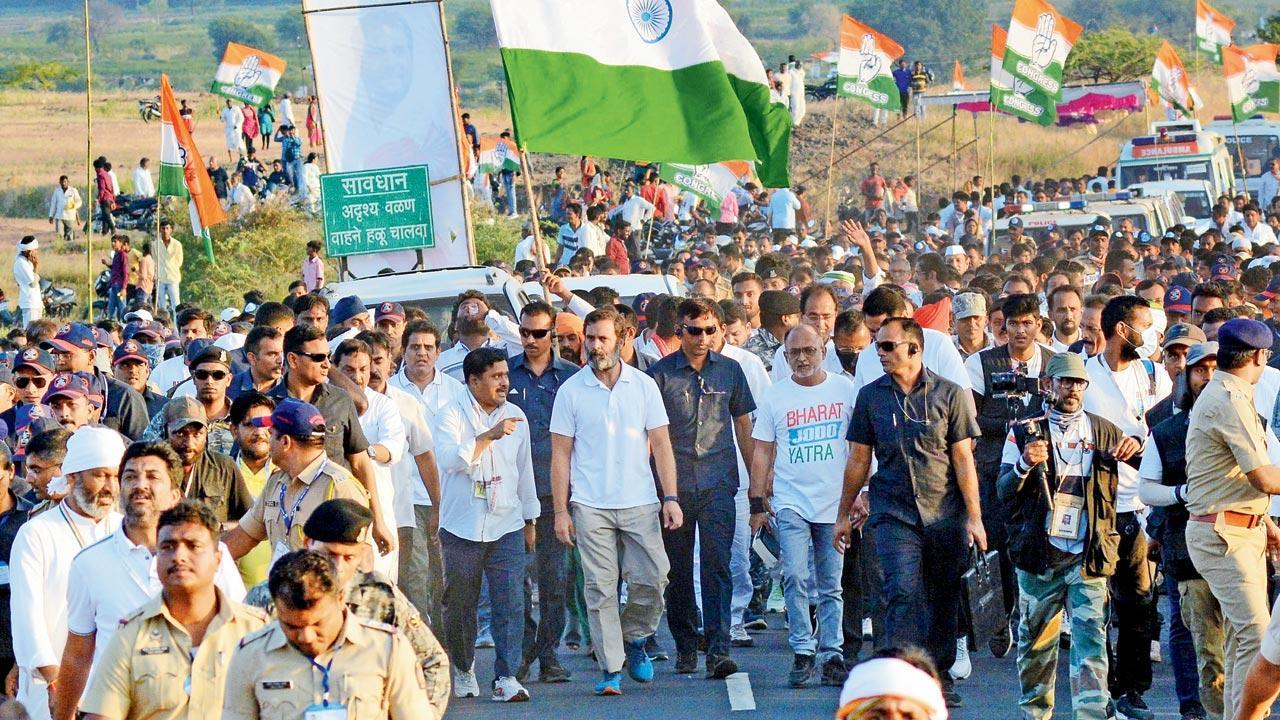
The Congress leader walks with members of the Yatra’s core team within an area cordoned off by the CRPF. After walking for days, several return disheartened when they couldn’t get in to talk with him
Degloor, Nanded: It is day 61 of the Bharat Jodo Yatra, a grandiose and ambitious attempt by Congress leader and Member of Parliament Rahul Gandhi to unite India as he traverses the length of the country—12 states and 3,500 km—from Kanyakumari to Kashmir on foot. At 4.30 pm, we are nearing the town of Degloor in Nanded district of Maharashtra, skirting the border of Telangana. Vast stretches teeming with jowar and lentil fields whiz past, as our vehicle follows a speeding convoy of cars on NH161.
ADVERTISEMENT
When the convoy halts, it’s outside a makeshift campsite in Biloli. Former Maharashtra Chief Minister Ashok Chavan, who last held the post of Guardian Minister of Nanded district and helmed the PWD ministry before the Uddhav Thackeray-led Maha Vikas Aghadi government collapsed in June this year, steps out for a recce. He inspects the arrangements, offering feedback to the coordinators, before heading towards Gurdwara Yaadgari Baba Zoravar Singh ji, Fateh Singh ji in Ibrahimpur, a few kilometres ahead. Here, he meets the heads of the gurdwara trust, listing out the itinerary for the day. Later that night, on the eve of Guru Nanak Jayanti, when Gandhi’s padyatra will enter Maharashtra, the gurdwara is where he will make his first halt, after being welcomed by the state’s Congress leadership at the Chhatrapati Shivaji Maharaj Statue in Kalamandir.
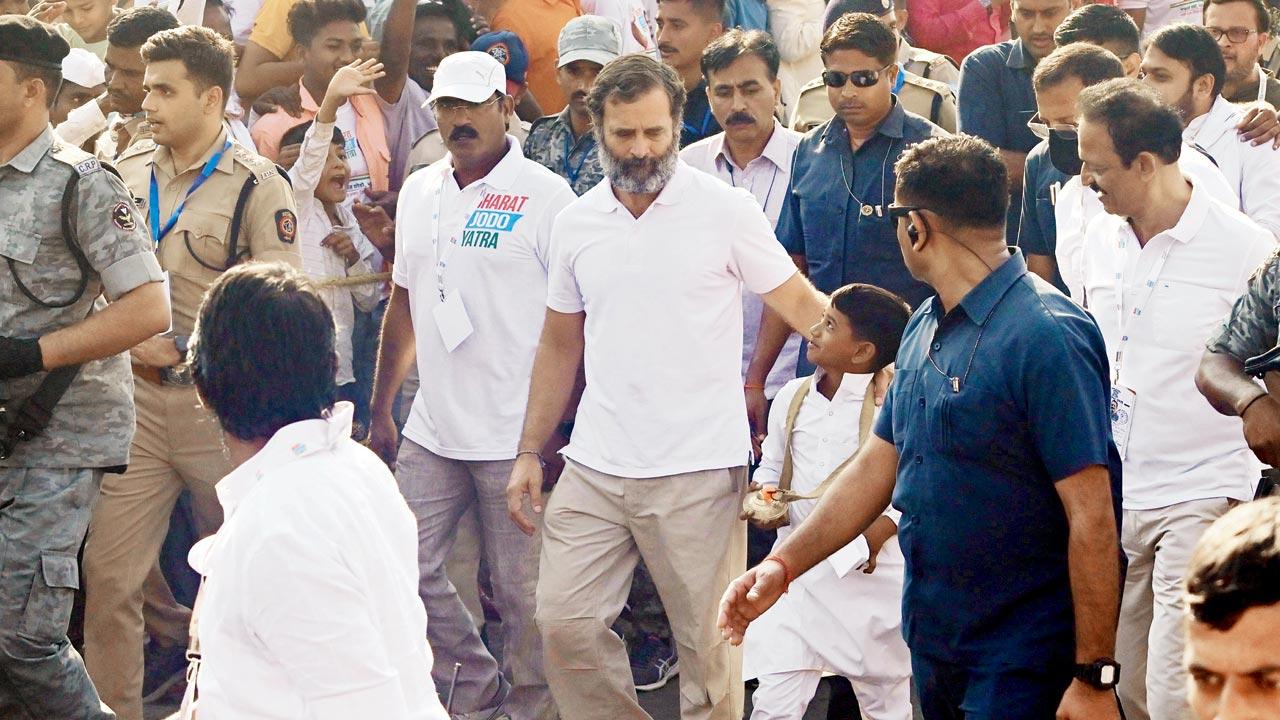 Congress leader and Member of Parliament, Rahul Gandhi, seen walking from Atkali village to Bhopala in Biloli, where he and his entourage camped for the night, before heading for Nanded. He was joined by several senior state leaders, including Bhai Jagtap and Nana Patole. Pics/Sayyed Sameer Abedi
Congress leader and Member of Parliament, Rahul Gandhi, seen walking from Atkali village to Bhopala in Biloli, where he and his entourage camped for the night, before heading for Nanded. He was joined by several senior state leaders, including Bhai Jagtap and Nana Patole. Pics/Sayyed Sameer Abedi
Everything is in order, Chavan is assured, before he leaves for a guesthouse in Degloor, where a posse of party workers are awaiting his instructions.
“It’s like a great big Indian wedding in Nanded for the next five days,” Chavan tells mid-day at the venue. “There’s a lot of enthusiasm and excitement among the villagers, especially from the interiors [of the region].” Preparations for the Bharat Jodo Yatra, he says, began early on in the year, after the Congress Working Committee met at the three-day Chintan Shivir in Udaipur in May. “That’s when this event was conceptualised.” In Nanded, a traditional Congress stronghold, work began over a month ago. “Planning for a day-long event is one thing; a five-day function is a different beast altogether.” But, the bigger challenge, he confesses, is keeping pace with Gandhi, 52. “He starts at six in the morning, and ends his walk around 7.30 pm [covering nearly 25 km daily]. It’s hard to keep up,” Chavan, 64, smiles, “I have not walked this long… never to this extent, at least. There’s a treadmill at home, so I’ve been walking to build my stamina. Let’s see, how much my body supports me.”
Over the next 14 days that Gandhi will be in Maharashtra, he will cover the districts of Nanded, Hingoli, Washim, Akola and Buldhana—the Nanded leg that will see him walk more than 120 km, encompasses one-third of the state’s sojourn. At the time of going to press, Gandhi had already covered 28 districts in six states, with 1,785 km to go. With this, he is almost halfway through the Yatra.

Gandhi, whose reputation as ‘Pappu’ (naïve and dumb)—an unimaginative nickname that the ruling BJP and other parties non-aligned with the Congress continue to latch on to—precedes him, has had to go back to the drawing board to fuel confidence among party workers and traditional Congress loyalists. Taking a backseat from leading the party—Mallikarjun Kharge took over the reigns as Congress president on October 26—after he became the poster boy of dynastic politics, was his first move. The Yatra, what is being described as a mass movement to unite the country against divisive politics and its concomitant problems, appears to be the second. Chavan doesn’t mince words when he says that with the political ups and downs, especially in Maharashtra, “there has been a feeling of despair among the cadre”. “People are feeling low about the future. But this sort of approach [by Gandhi] to directly reach the masses and party workers is unique,” he admits, “It will energise and mobilise them.”
At the guesthouse, just hours away from the evening’s event, Nana Patole, current President of the Maharashtra Pradesh Congress Committee (MPCC), declares that he is positive about the success of the Maharashtra leg of the Yatra. Over the next few days, Patole will be seen matching steps with Gandhi. “A friend in his 80s, BG Kolse Patil Saheb [former judge of the Bombay High Court], is my inspiration. He has been walking from Kanyakumari with Rahul Gandhi. That’s given me the confidence to join the movement as well,” he says. “I will be walking with him till Jalgaon [in Buldhana].” He clarifies that this is not a “political movement”, even though the Congress is leading it. “We are fighting those looting our country. The Congress’ struggle is not new. We have won many elections, and even lost many. But that’s not the focus here. Hume satta se prem nahin, hume desh se prem hai [We do not love power, we love our country].”
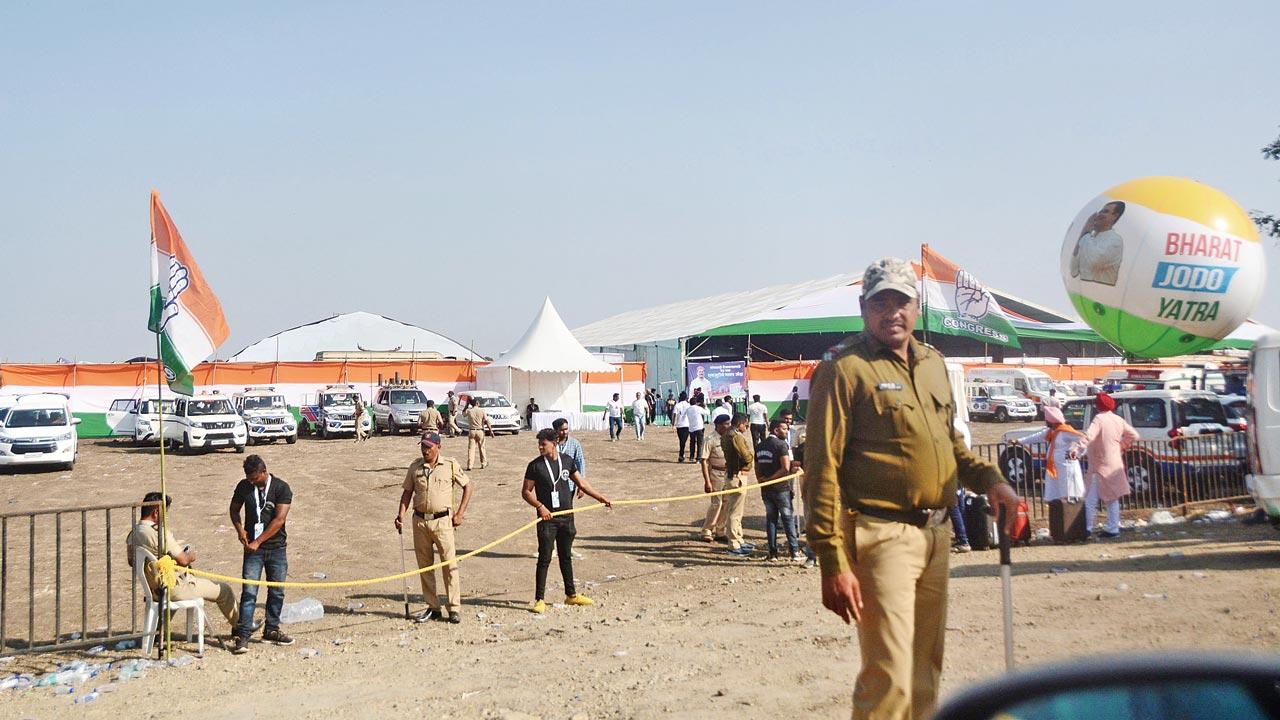 The makeshift campsite at Biloli in Nanded district, where arrangements were made for Gandhi, members of the core team, as well as other yatris
The makeshift campsite at Biloli in Nanded district, where arrangements were made for Gandhi, members of the core team, as well as other yatris
Patole harks back to Mahatma Gandhi’s 24-day-long Dandi March of 1930 against the taxation of salt, which covered 385 km from Sabarmati Ashram to Dandi. “That was also for the cause of the people,” he says, adding that not all yatras by leaders put the “people of the democracy at the forefront”. “[BJP leader] LK Advani ji’s Ram Rath Yatra [of 1990] was religious in nature. It was self-serving,” he claims, adding, “I’ll repeat that we are not concerned with how this yatra will help the Congress,” he insists. “Congress has always shown respect for India’s democratic tradition. And an important part of our democracy is the voice of the Opposition. But the ones in power today want to crush the Opposition as well as the fourth pillar of our democracy [the media].”
At Kalamandir that evening, in a show of strength, senior party leaders Sushilkumar Shinde, Digvijaya Singh, Prithviraj Chavan, Manikrao Thakre, Sanjay Nirupam, along with Rajya Sabha member and head of the Congress’ communications wing Jairam Ramesh, took over the dais. The song, Bharat jodne nikla dekho neta humara, with its impassioned lyrics had dancers from the Dhangar and tribal communities, fuel the milling crowd. When finally, Gandhi arrived at 9 pm, an hour behind schedule, he kept it short after paying his respects to the statue of Chhatrapati Shivaji—“Yatra main hum lambe bhashan nahin karte [I don’t give long speeches during the Yatra]. Whoever wants to speak with me, whether it’s my farmer friends, daily wage workers, businessmen, youth, or elderly... my doors and heart are open for them.” His claim of being accessible, at least in that moment, drew a roar of applause. How much of that will play out during the walk, remained to be seen.
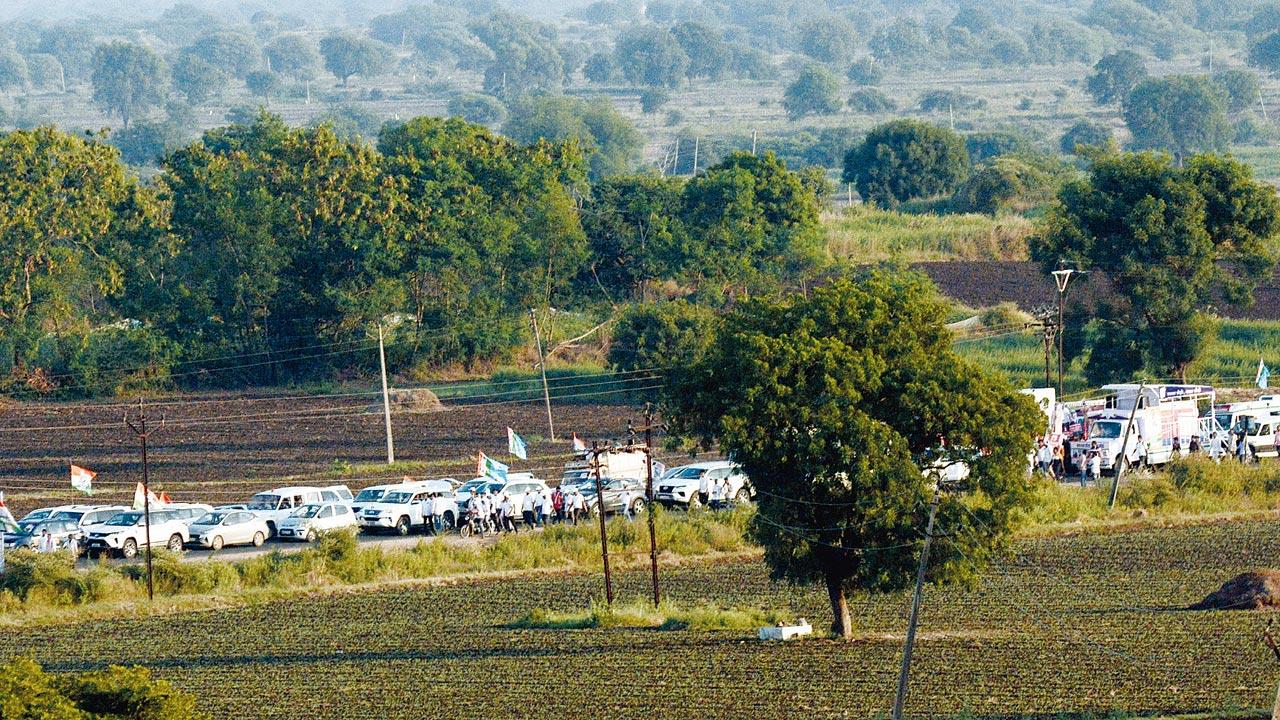 A cavalcade of vehicles with senior party workers and emergency ambulances seen following the yatris who had arrived in droves to join the Bharat Jodo Movement in the Nanded district
A cavalcade of vehicles with senior party workers and emergency ambulances seen following the yatris who had arrived in droves to join the Bharat Jodo Movement in the Nanded district
As Gandhi left with his entourage of yatris—mashaals in tow—for the gurdwara, a sea of people gathered, some using the moment to unfortunate advantage and groping women on the way. They ran behind him, almost risking a stampede; heady, as if they were, by this promise of change.
Navi Mumbai resident Dr Manoj Upadhyay is among the nine people from Maharashtra, who are part of the 120-member core team that is covering the entire stretch with Gandhi over 150 days. He has been associated with the Congress for 30 years. Upadhyay, who runs the Balaji Multi Speciality Hospital and ICCU, has taken a four-month break from his practice to accompany Gandhi, “because I wanted to be part of this historic moment”. “When the government becomes mute and deaf, and people come alive on the roads, it means that the seeds of change are being sown.”
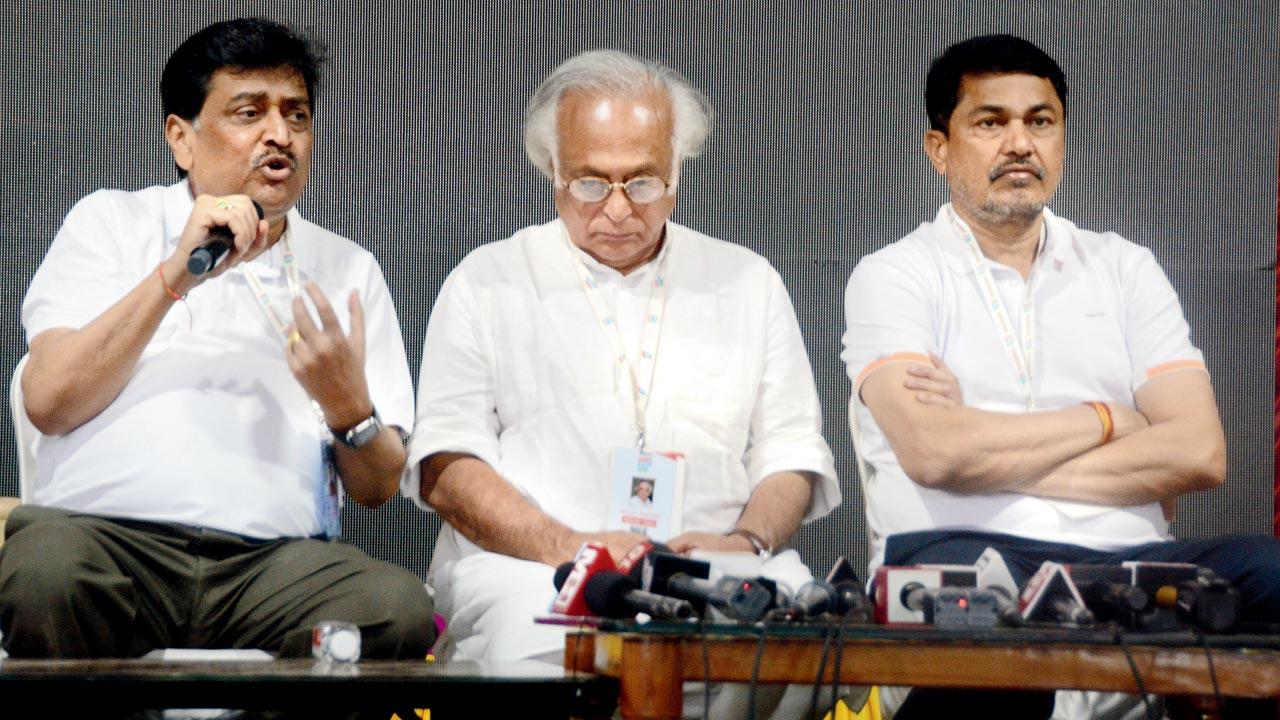 Senior Congress leaders Ashok Chavan, Jairam Ramesh and Nana Patole during a media briefing
Senior Congress leaders Ashok Chavan, Jairam Ramesh and Nana Patole during a media briefing
The team has been living out of portable containers for the last 60-odd days. “We usually wake up at 4 am. Some get up as early as three in the morning. We get ready, have breakfast and at 5.30 am, we fly the tri-colour, before starting the walk,” he says. The yatris usually walk till 10 am, before taking a break. They resume around 4 pm, continuing till about seven in evening, before camping at a new site. Their containers travel ahead of them. The team covers nearly 25 km daily. Upadhyay remembers the initial days being tough on him. “The first 10 days were bad. I was on painkillers. Luckily, I got only a few blisters on my feet. But, I experienced severe muscle pain and cramps. It takes a toll on the body. But, hum mein junoon hai,” he says.
Like him, Dr Shravan Govindrao Rapanwad from Nanded has been walking with Gandhi since September 7. “My family couldn’t take part in India’s Independence struggle, but it’s an opportunity I wish I had had. When I came to know about the Bharat Jodra Yatra, I decided to go for the screening interview. I shut my dispensary for five months,” he tells us in Marathi. Rapanwad hasn’t skipped a day since he started walking. “I didn’t take a holiday even for Diwali. We celebrated the festival with our friends in the container, lighting diyas.” His wife, a lecturer and gynaecologist, Dr Deepali Rapanwad, motivated him to take this break from his career.
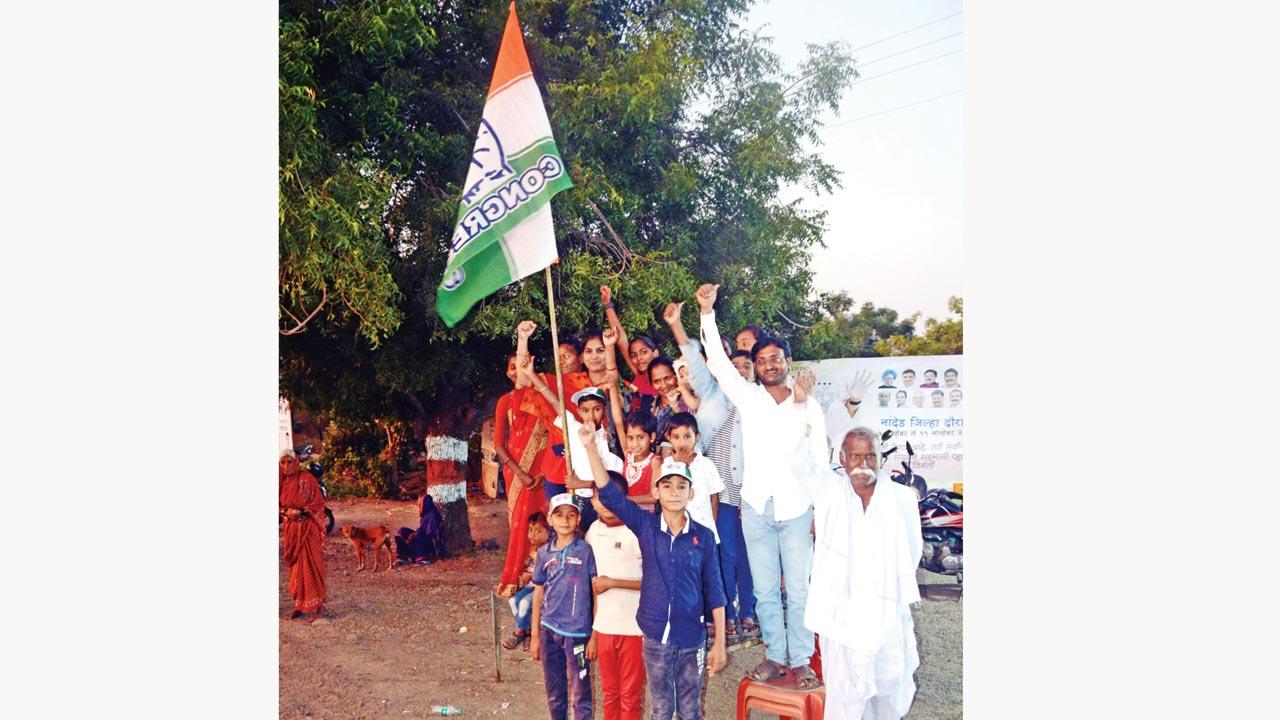 Women from the Khise family that travelled to Biloli from Bijur in Nanded district, say inflation has affected them badly. On some days, they don’t have food on the table. They aren’t even able to give all their kids an education
Women from the Khise family that travelled to Biloli from Bijur in Nanded district, say inflation has affected them badly. On some days, they don’t have food on the table. They aren’t even able to give all their kids an education
The youngest member in the Yatra team is 24-year-old Vaishnavi Bharadwaj from Nagpur. Bharadwaj says that her fight is against casteism and unemployment. The national coordinator of the National Students’ Union of India (NSUI), she was orphaned a few years ago. Gandhi, she says, has egged her on, reminding her that “I should never stop taking decisions for the greater good. Some may work in my favour, so may not, but Rahul ji says we must not stop.”
Barely a few hours before we met with the yatris, news of Congress Seva Dal’s general secretary Krishna Kumar Pandey, collapsing at the morning rally, came in. Jairam Ramesh later told the press that the yatra had kicked off at 8.30 am, as the meeting at the gurdwara the previous day, had gone on till late. Pandey had been carrying the flag, walking alongside Ramesh. “After 15 minutes of walking, he handed over the flag to someone else, and went and joined the crowd,” he said. Kumar collapsed soon after, and was rushed in an ambulance, but didn’t make it. A condolence meeting followed soon after, where Gandhi paid his respects to Pandey and his family, before continuing with the yatra at 4 pm. Only this time, Ramesh said they had decided to walk in silence, and requested that no music be played.
![Ramchandra Chauhan, who has a cement shop in Ujjain, first learnt about the yatra on the Internet. He says he hasn’t eaten for days on end, and has been sleeping on the roads. “[But] I am determined to not quit. I want to join Rahul ji till Kashmir. But, if it gets unbearable, I will have to return,” he says](https://images.mid-day.com/images/images/2022/nov/walking-randhi-g_e.jpg)
Ramchandra Chauhan, who has a cement shop in Ujjain, first learnt about the yatra on the Internet. He says he hasn’t eaten for days on end, and has been sleeping on the roads. “[But] I am determined to not quit. I want to join Rahul ji till Kashmir. But, if it gets unbearable, I will have to return,” he says
There’s a groundswell of support for Gandhi that afternoon. Farmers and daily wage workers have taken a break to line the roads, and catch a glimpse of the Congress leader. Many of the elderly in the crowd identify him as Indira Gandhi’s “naatu [grandson]”.
People have come here for different reasons, some personal, some political and social. Tirupati Devidasrao Baswade, an employee with the Maharashtra Gramin Bank, has travelled from Nanded to Degloor, to join the Yatra over the next three days. He is concerned about the government’s slew of decisions on the Regional Rural Bank (RRB). According to a report in a financial daily, “India has 43 RRBs with a network of around 22,000 branches, which ensure banking facilities for farmers and artisans. These banks collectively employ one lakh people.” The government has been working on a policy to bring regional rural banks under a holding company. Last year, employees went on a strike against the government’s plan to divest its 50 per cent share in each of the rural banks in favour of their respective sponsor banks. “The RRB was started to help the villagers, and many of them have access to government schemes through these banks. It helps nearly 40 crore villagers. If RRB is privatised, where will they go... they won’t be able to afford the charges of sponsor banks.” Baswade also hopes that the compulsory KYC for farmers is scrapped. “They have accounts in different banks, but their Aadhar is linked to only one bank. Sometimes, they have to travel between banks, just to get small things sorted. It’s proving to be quite a hassle for them.”
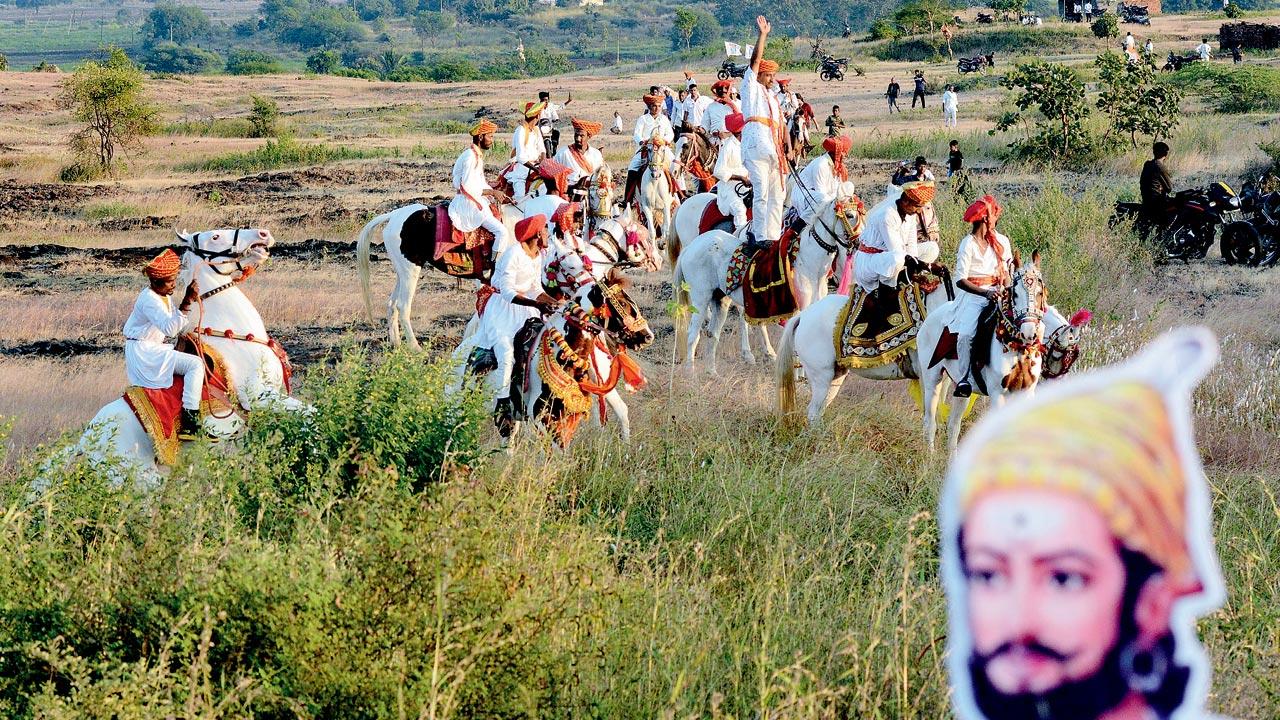 Men dressed in traditional attire arrive on horseback to welcome Gandhi
Men dressed in traditional attire arrive on horseback to welcome Gandhi
The Khise family has travelled here from Bijur in Nanded district. Around 10 of them stand on a table that they’ve brought along, hoping to catch Gandhi’s attention, when he passes by. “Mehngai [inflation]” is what has brought them here. “Everything has become so expensive, and our land has no value anymore,” says Hemlata Rameshwar Khise, whose husband is a jowar farmer. “Humari zaroorate poori nahin ho rahi hain [We are unable to meet our needs],” she adds.
“When it comes to educating my children, I have to make a choice. One of them stays at home, and the other goes to school. I cannot afford to send both. There have been days, when we’ve gone hungry. I want a better life for my family.”
 Wheelchair-bound Bijur resident Sunita Bandegar attended the Bharat Jodo Yatra to address her concerns about her village
Wheelchair-bound Bijur resident Sunita Bandegar attended the Bharat Jodo Yatra to address her concerns about her village
Wheelchair-bound Bijur resident Sunita Bandegar was among the fortunate few, whom Gandhi took notice of. He got hold of her wheelchair and rode along for a few minutes, while speaking to her. Bandegar is here to speak for her village, which has no regular water supply. “It’s been 75 years since Independence, but the problems are the same as those my grandparents witnessed. Two years ago, we were given a gas pipeline, but the price of LPG is rising every month. How can we afford to pay Rs 1,500 for fuel? We are back to using firewood.”
Gandhi has assured he will listen, if and when people come to him. But the Central Reserve Police Force (CRPF) cover is an impenetrable wall, even for this writer, with a media pass. We were roughed up, and pushed out, when we made an attempt to enter.
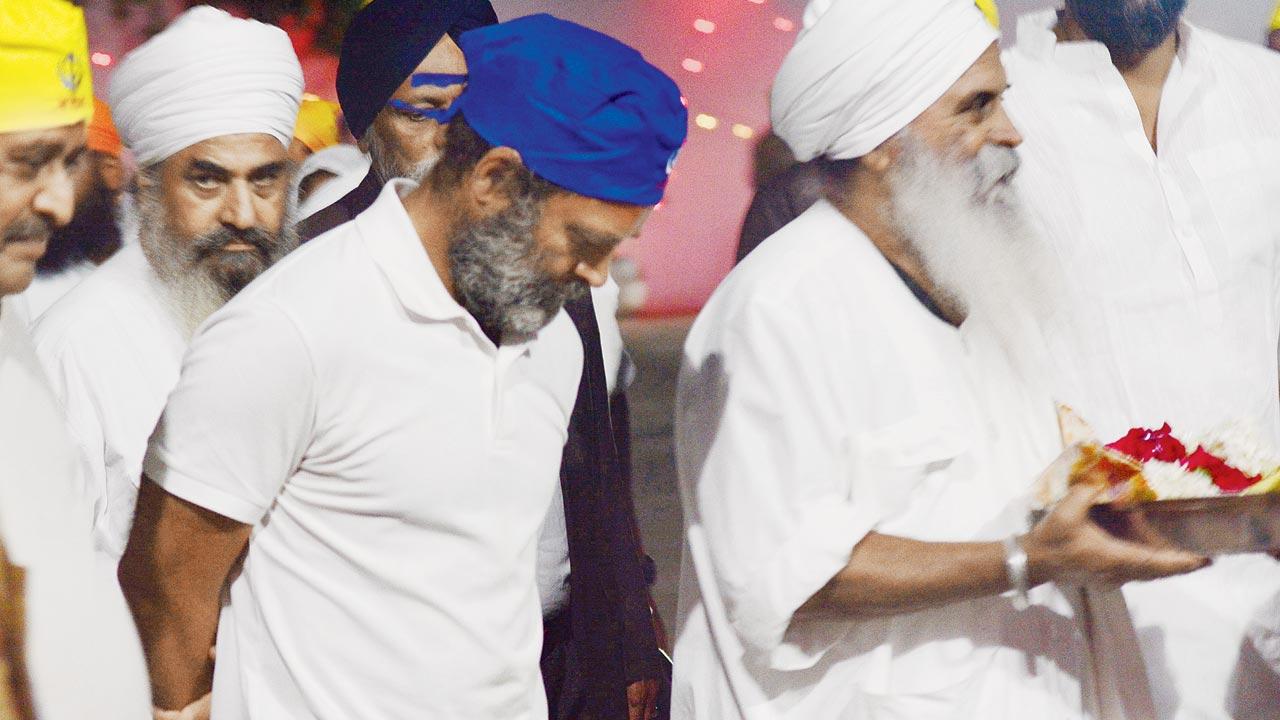 Gandhi met with religious heads of the Gurdwara Yaadgari Baba Zoravar Singh ji, Fateh Singh ji in Ibrahimpur, on the eve of Guru Nanak Jayanti
Gandhi met with religious heads of the Gurdwara Yaadgari Baba Zoravar Singh ji, Fateh Singh ji in Ibrahimpur, on the eve of Guru Nanak Jayanti
Ramchandra Chauhan hasn’t been able to penetrate this cordon either. The man from Madhya Pradesh is broken and disheartened, because despite walking over 22 days, he hasn’t been able to secure a meeting with Gandhi. Chauhan has a cement shop in Ujjain, and first learnt about the Yatra on the Internet. He is seen wearing a poster which has the photograph of a farmer in a field, demanding an end to farmer suicides, unemployment and rocketing LPG prices. “After the losses I suffered during COVID, I was done for good. In Rahul ji, I saw hope, so I decided to join the Yatra in Karnataka. My wife and daughter told me that I wouldn’t be able to do it, but I didn’t listen,” says Chauhan, who has been walking in a pair of chappals. At this point he breaks down. “I have developed blisters... I haven’t eaten in three days. On most nights, I sleep on the street, without a blanket. Sometimes, I am forced to walk with my jhola, because there’s no place to keep it in the camp.” He asks us if there’s a way he can register and get a pass, or get hold of ours to get entry into the camp. “I am determined to not quit. I want to join Rahul ji till Kashmir. But, if it gets unbearable, I will have to return.”
At an event that same evening, Gandhi spells out the reasons why he has embarked on this journey—joblessness, demonetisation, GST and the autocratic rule of the Bharatiya Janta Party. The concerns are real, but Gandhi’s oratory skills fall short of the performance required to match his rivals. His partymen insist they are here to present the “real Rahul Gandhi” to the masses. “Nobody is talking about the Yatra,” they argue, accusing mainstream media of bias and silencing Gandhi’s voice, projecting him as a leader without a thinking mind. Patole tells us, “We are not accusing the media... we just want them to do their job.”
 (From left) Aatisha, Dr Manoj Upadhyay, Vaishnavi Bharadwaj, Pinki Singh and Dr Shravan Govindrao Rapanwad are among the nine people from Maharashtra who are part of the 120-member core team that is covering the entire stretch with Gandhi over 150 days
(From left) Aatisha, Dr Manoj Upadhyay, Vaishnavi Bharadwaj, Pinki Singh and Dr Shravan Govindrao Rapanwad are among the nine people from Maharashtra who are part of the 120-member core team that is covering the entire stretch with Gandhi over 150 days
The irony of the political cadre critiquing the Indian press in front of mediapersons, was not lost on us. Mumbai-based writer-journalist Dilip D’Souza who joined the Karnataka leg of the journey, says he was there “partly because something like this gets my journalistic antennae quivering sharply”. “I wanted to simply watch and observe. In some sense, I am not even really invested in the success or otherwise of the Yatra. Partly too, this was something I felt I had to do to stand up to the divisiveness, the hatred, the polarisation that is deepening so many faultlines in this country. My solidarity with—luxuriating in, more like it—the diversity of India may mean very little in the broader sense. But it means a great deal to me, and that’s what took me to the Yatra,” he says. D’Souza says that while the regional press was there in droves—at least two trucks—he didn’t see any sign of the top television networks or famous anchors. “Should they have been here? There have been many accounts of walking with the Yatra from journalists and others—Shoaib Daniyal, Abhilash Prabhakaran, Shivam Vij, [and] me. But there’s also the fact that while the Yatra is a remarkable spectacle and a unique event, it isn’t really producing ‘news’ daily. I don’t think there’s a case for continuous coverage... That happens only when it enters a new state or big city, or even when, sadly, one of its activists dies while walking.”
Indian digital news website Scroll’s political editor Shoaib Daniyal’s piece on the absent media, The #1 enemy at Congress’ Bharat Jodo Yatra isn’t the BJP—it’s the media, also points out how “much of the Yatra is laced with anti-media messaging”. “In fact, many senior strategists argue that the Congress had to resort to devices such as the Yatra precisely because the media is hostile to them,” he writes. Speaking to mid-day, Daniyal says the coverage in national media, has been sparse. “But, it’s not like the Congress is going out of its way either to get the media to cover the Yatra, especially in areas away from urban centres.” The Yatra, he says, is its own animal and comes with logistical challenges. “I think the Congress is so disillusioned with the media that they aren’t even actively seeking coverage. Whether it’s an oversight or part of their strategy, I cannot say.”
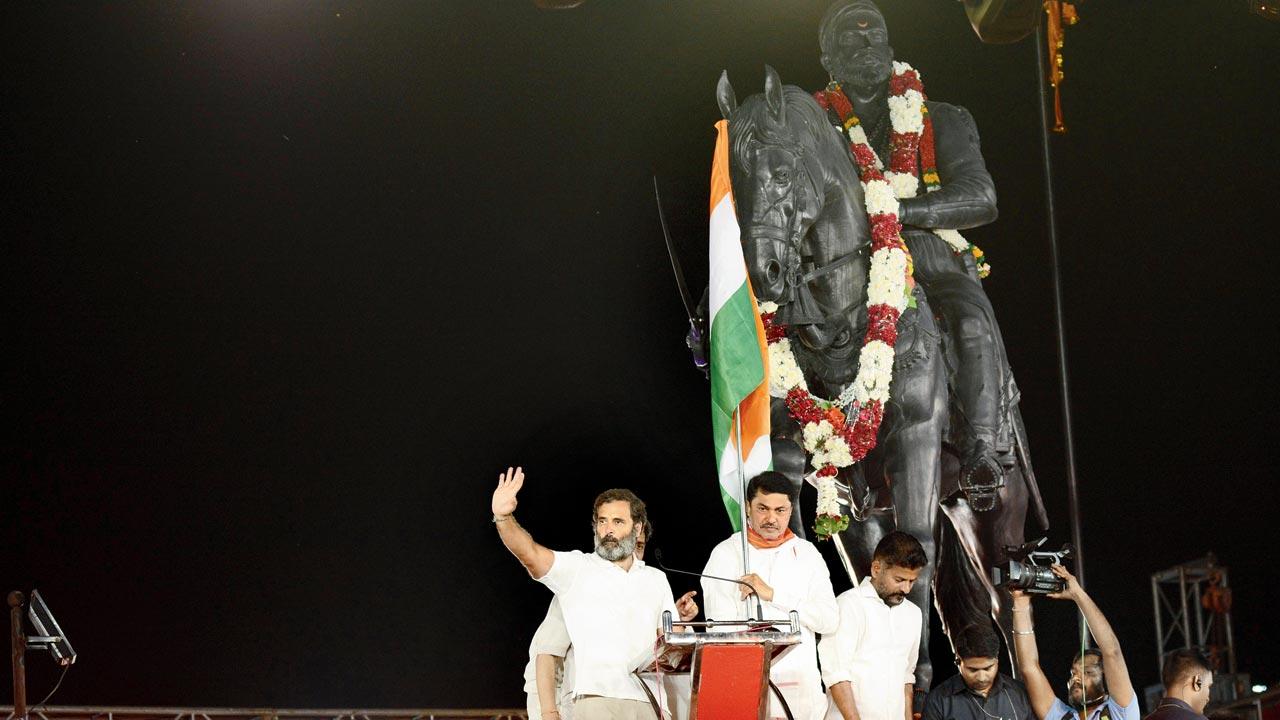 Congress leader Rahul Gandhi at the Chhatrapati Shivaji Maharaj Statue in Kalamandir, which marked the beginning of the Maharashtra leg of the Bharat Jodo Yatra
Congress leader Rahul Gandhi at the Chhatrapati Shivaji Maharaj Statue in Kalamandir, which marked the beginning of the Maharashtra leg of the Bharat Jodo Yatra
Daniyal, however, finds the Congress’ outreach and mode of politics, very interesting. “It really does believe that the media is hostile to it, so it’s going to go and establish direct contact [with the people], while tapping into tropes of Gandhian sacrifice.”
D’Souza says that he doesn’t remember seeing anything like this anywhere. “Who is the last political leader or party anywhere in the world to have done this on this scale?” Even Advani’s rath yatra, he says, had him riding around in an AC “Toyota that he dressed up as a chariot”. “Is there a parallel to the Dandi March? Yes, in the sense that it was on foot too. This one is bigger and longer. But no also, in the sense that Dandi had a tightly-focused aim with huge implications: challenge the salt tax and galvanise a country against colonial rule. This yatra doesn’t have that kind of narrow aim, though of course, in the end, they hope it will bring an Opposition together to defeat the ruling party in the next election.”
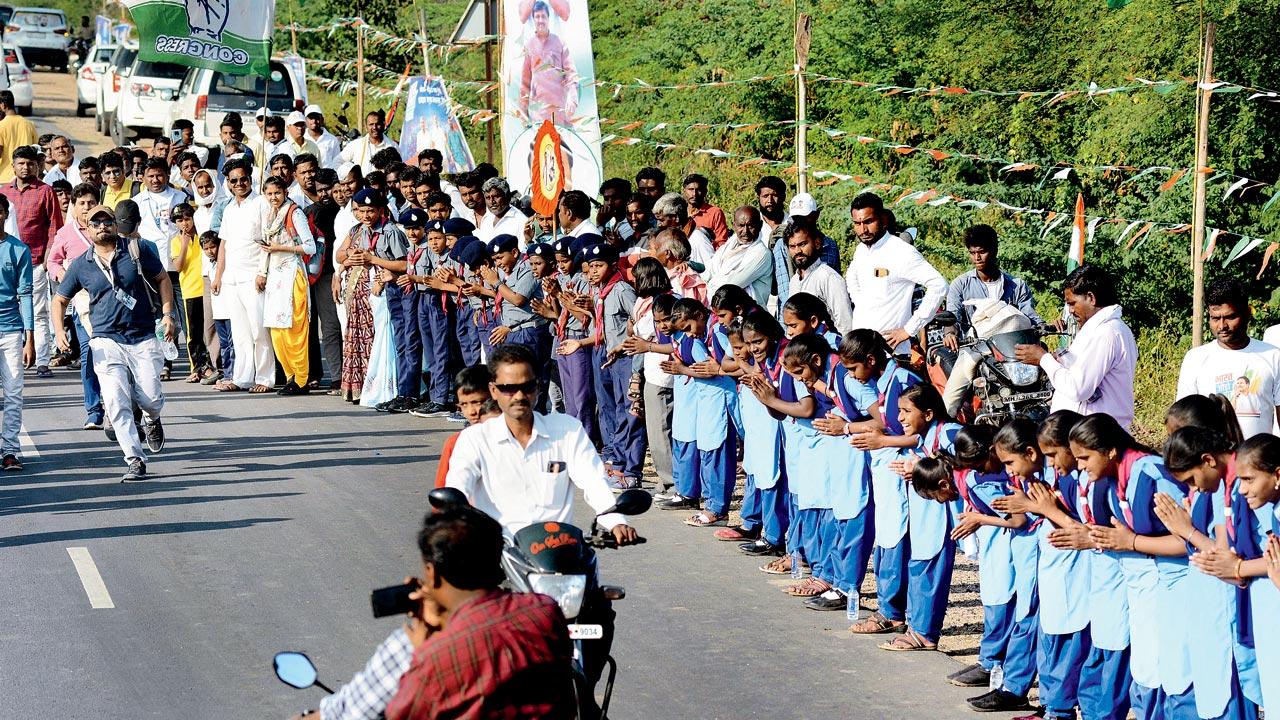 Girl Guides line up to greet Gandhi
Girl Guides line up to greet Gandhi
Apart from developing a sense of discipline, Jairam Ramesh tells mid-day that what the Congress party has managed to do is re-establish a narrative with the people. “We were reacting... we were defensive all the time. I think Bharat Jodo has set the tone for a different kind of politics. Not to mention, we are very visible on the roads now. For Mr Gandhi, personally, it’s a sense of connectivity. For the Congress, as a whole, it’s a sense of collectivity.”
But will this effort, even if laudable, by Gandhi and Co., upset the apple cart? Journalist Aatish Taseer who is contributor to the T Magazine of The New York Times, says, hardly. “I think what matters, especially if you’re the leader of the Opposition, is not a yatra, but an actual democratic result in an election. Imagine how weird it would be if Keir Starmer was to lead a yatra against Rishi Sunak. Just win the election.”
385km
Distance Mahatma Gandhi and 78 Congress volunteers covered from Sabarmati Ashram to Dandi to protest the salt law in 1930
1,715km
Total distance covered so far by Rahul Gandhi across 6 states and 28 districts, according to senior Congress leaders
 Subscribe today by clicking the link and stay updated with the latest news!" Click here!
Subscribe today by clicking the link and stay updated with the latest news!" Click here!







